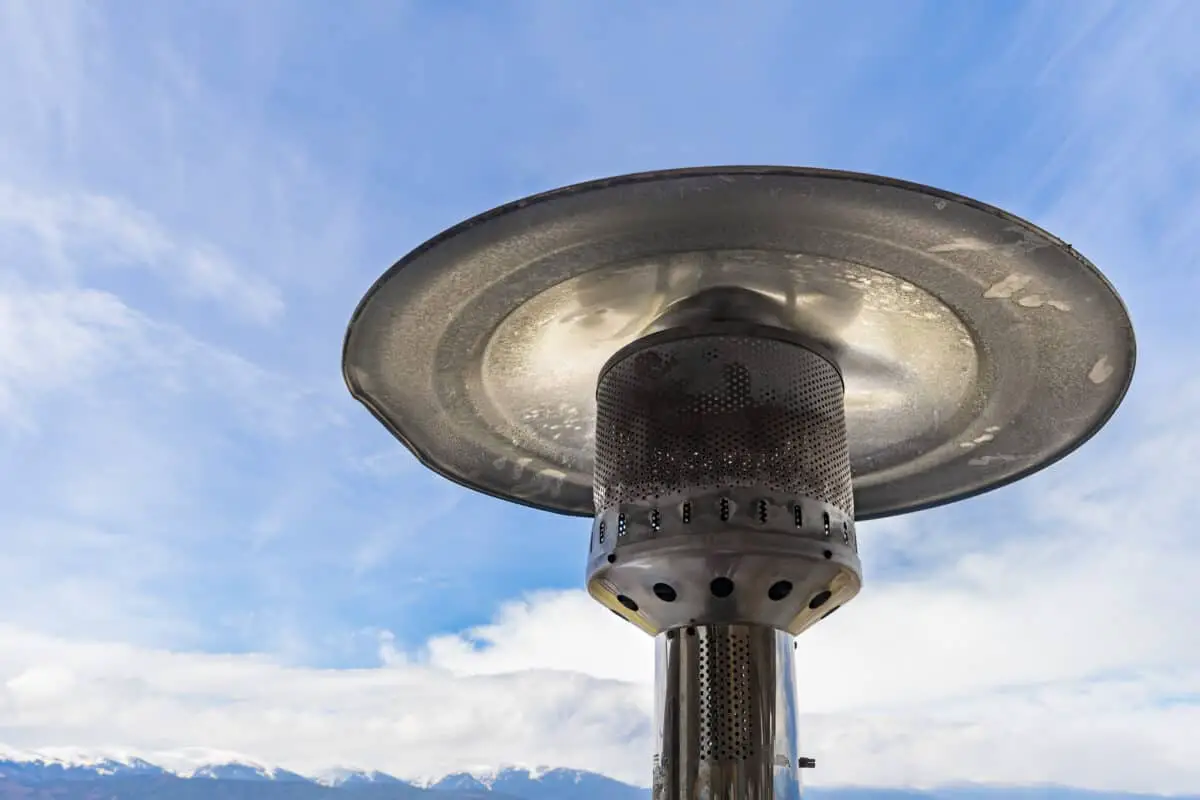Patio heater safety can be obtained if a few precautions are taken.
For instance, if they’re being used under a covered patio, there must be sufficient clearance between the top and the roof of the patio.
Also, free-standing heaters need a tilt-detection auto-shutdown system to shut off the heater should it lean or fall.
A good patio heater can extend the usability of your patio from just the warmer seasons to the entire year.
These heaters are a great way to make the most of your patio space during the cooler seasons.
However, many people are concerned with patio heater safety using these heaters.
In this article, we will explore this question further.
We will figure out all the safety concerns regarding patio heaters and how to mitigate them so that you can enjoy these wonders of modern technology and make the most of your patio.

Related Reading: Can I Put a Patio Heater on a Wooden Deck?
Table of Contents
Patio Heater Safety Comparing the Various Types
Let us start by looking at the various types of patio heaters available, each with its safety concerns.
There are, at the most basic level, three kinds of patio heaters available on the market, categorized based on the fuel type they use:
- Propane gas
- Natural gas
- Electricity
Certain types of heaters have distinct advantages and disadvantages. Electric patio heaters, for instance, are a better fit for under a covered patio.
Safety Concerns With Propane Gas-Powered Patio Heaters
Propane gas-powered patio heaters use some sort of propane gas tank as their fuel source, being a very popular heater.
They are most popular in the form of umbrella heaters.
But there are other shapes available, like pyramid patio heaters.
Propane Gas-Powered Safety Concerns
- Generally speaking, these heaters are heavy enough to hold their ground. But under highly windy conditions or due to accidental tipping, they could fall. This could result in a fire. Getting a heater with an automatic tipping detection system that shuts the unit off when tipped is advisable.
- These are generally very tall heaters, standing around 8 feet high. If there isn’t enough clearance between the roof of the patio and the top of these heaters, there could be safety concerns.
- Since patio heaters operate on radiant heat, all combustible materials must be kept at least six to eight feet from the heater. These include plants, papers, wood, umbrellas, etc.
- These units can get hot, so leaving them around children and animals could lead to safety issues—fortunately, the best patio heaters in the market account for this in their heat delivery system.
Patio Heater Safety Concerns-Natural Gas-Powered
Natural gas-powered patio heaters are directly connected to the natural gas lines that are connected to our homes.
As such, they are usually not portable and are instead fixed to a certain section in your patio.
While this does mostly solve the issues regarding tipping, igniting of combustible materials, and clearances (all of these can be accounted for when setting the heater up), there are still some impending issues, which are:
- If the natural gas lines are not connected properly, it could lead to gas leakage, which could, in turn, lead to a grave fire hazard. This can be resolved using a gas regulator and regularly checking and cleaning the gas hose.
- Unlike propane gas heaters that usually run out of gas after 10 to 12 hours of burning, natural gas-powered heaters can go on for a long time. So, forgetting to shut them off could lead to severe consequences and increased danger when lighting them. Always remember to shut the heater off after you’re done using it.
- Like the portable patio heaters, these units still tend to get too hot for children and animals to roam freely around them. Installing a barrier around a certain radius of the heater can help prevent this problem.
Safety Concerns With Electric Patio Heaters
Electric patio heaters are powered by electricity, which heats a filament, radiating the heat in this vicinity. These have their specific patio heater safety concerns.
Electric patio heaters should not be exposed to rain and are not waterproof, so leaving them outdoors indefinitely can cause them to malfunction or damage.
While they may generally seem safer than gas-powered patio heaters, electric patio heaters come with their own set of safety issues, which are:
- Electric patio heaters are generally smaller than gas-powered ones and are much more likely to be tipped over by powerful winds or accidents. Invest in an electric patio heater with a tip-detection system that automatically shuts down the heater upon tipping.
- Since electric patio heaters are connected to electrical outlets using power cords, if they are not secured, there is a reasonable risk of someone tripping on it and consequently tipping the patio heater. Consider investing in wire-securing clamps so that the wires are held securely.
- Another important consideration with electric patio heaters is that, unlike propane-powered patio heaters, they are connected to the electric mains, which means they will continually get powered unless shut off. This can lead to severe consequences. Consider investing in an electric patio heater that comes with a timer feature.
- Due to problems in the electric supply or other issues, the filament could get hotter than usual, resulting in a fire hazard. To prevent this, you should invest in a heater with a feature that automatically shuts it off once the filament exceeds a specific temperature.
Final Word on Patio Heater Safety
As we saw in the list above, bearing in mind a few precautionary steps, patio heaters are generally safe to use.
However, you can still review this checklist to enhance patio heater safety.
Patio Heater Safety Checklist
- With gas-powered patio heaters, always have a gas regulator installed. Make a habit of turning the regulator off each time you are done using the patio heater.
- Create a barrier around these heaters so that children and pets cannot run into it. This can prevent them from getting burnt.
- Regularly check for rust and leakage in the gas tanks. Also, check for leakage or blockage of any kind in the gas hoses.
- Always place portable heaters at a safe clearance from the walls and the ceilings. Keep the heater at least 3 feet away from any wall or the ceiling.
- All combustible materials, such as wood, paper, umbrellas, rugs, cushions, etc., should be kept safe from the heater. This distance depends on the type and power of the heater being used. But generally speaking, a minimum distance of 6 feet should be maintained.
- Care must be given to regular maintenance of all patio heaters. More often than not, safety issues arise from ignoring failing parts and mechanisms within the heaters.
- If you own a public space using patio heaters, you should be extra careful about the safety issues. Consider having a safety inspector inspect the heaters and check for any impending hazards before they strike. The safety of the public is a graver issue than your own.

Conclusion
Having patio heater safety at the forefront will ensure reducing risks while enjoying your heater.
Remember, there are three heaters with different means of producing heat. Each of the three kinds of patio heaters has its unique set of patio heater safety issues.
However, there are ways you can prevent any of those issues from actualizing by keeping a few simple tips in mind.
Gas-powered heaters are a popular choice in outdoor heating these days, which has improved both their quality and safety.
I hope this patio heater safety insight helps you enjoy being outside during cooler weather with peace of mind.
Be Safet!
Enjoy living the outdoor life!!!
